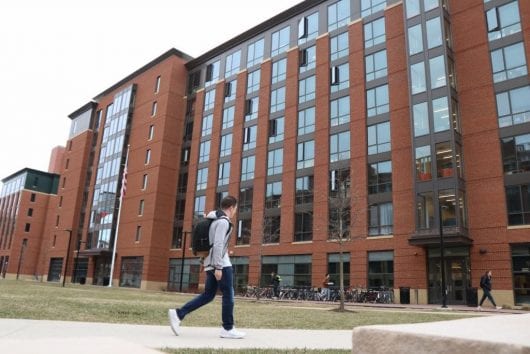
Blackburn House came in first place with a 10 percent reduction. Credit: Casey Cascaldo | Photo Editor
The first-ever Campus Energy Competition, held by Ohio State Energy Partners and the Office of Student Life, ended Friday, with the top three residence halls reducing energy use by an average of nine percent.
The competition began March 25 and measured energy reduction in each of the 15 participating dorms. Blackburn House came in first place with a 10 percent reduction, and Raney House came in second place with a 9 percent drop in energy use. Residence on Tenth saved 8 percent, coming in third place.
“On a big campus like this, it’s only going to keep growing,” said Dominique Hadad, intern at ENGIE — whciw manages the university’s energy — and director of sustainability for Undergraduate Student Government.
Hadad said the competition was successful for their first year, with students learning about the competition and engaging in ways to save energy while living in their residence halls.
According to the data collected, all but two residence halls saw at least a 1 percent decrease in energy consumption. Scott House saw no change, and Nosker House increased their energy use by 8 percent.
Through ENGIE’s tabeling events, students were exposed to the importance of conserving energy prior to the competition. While they tabled with the intention of discussing the competition, Hadad said they also interacted with students about sustainability.
One of the goals for ENGIE was to make the competition a way for students to recognize and understand how the view on energy has shifted, Marisa Twigg, an ENGIE intern, said.
In the past, energy was looked at from a monetary standpoint, Twigg said, but ENGIE wanted to use this competition as a chance to educate students on how to be sustainable and save energy when the time comes to move to off campus housing.
“I think energy can sometimes be a more difficult subject to navigate,” Twigg said. “Students are usually not thinking about the energy that they’re using.”
Some residence halls were different from others in terms of what each smart meter measured.
The smart meters are digital meters that work to capture all energy use in an entire building every 15 to 30 seconds. Lighting, electricity and chilled or hot water were some of the variables measured and tracked over the three weeks.
In order to continue to correctly track the data throughout the competition period, Twigg said it was important to readjust as time went on.
This included factoring in baseline data — energy numbers from the past that the team looked at to determine at what numbers each residence hall had to start. These change each year from factors like the weather, making the team have to reassess data and standardize the temperatures.
The competition is currently held just for 15 residence halls, but Twigg said the goal for the next two years is to continue to install smart meters, allowing more to compete in the following years.
This year, participating North Campus residence halls included Torres House, Mendoza House, Scott House, Blackburn House, Nosker House, Jones Tower, Houston House, Taylor Tower, Raney House, Bowen House and Bush House. South Campus residence halls included Siebert Hall, Park-Stradley Hall, Smith-Steeb Hall and Residence on Tenth.
Each of the three winning residence halls will receive pizza and desserts for their success in reducing energy.


